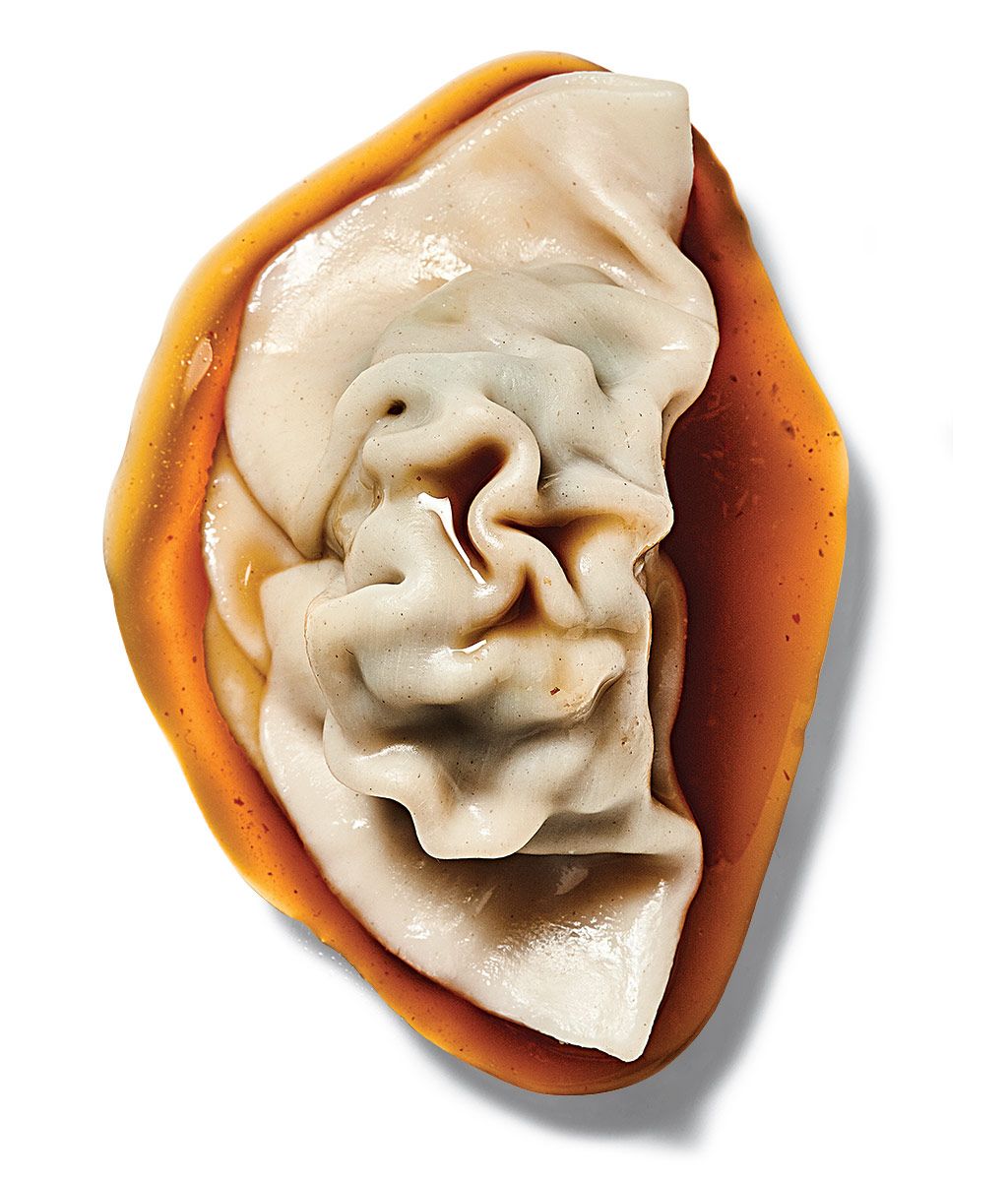We’ve found the 50 best dumplings in New York and talked to some grandmas who are experts at making them. But there’s even more to know about the city’s dumpling universe. Here, an everything guide, including architects’ tips for building a better one, how to make 20 mandu in five minutes, what to dunk them in, and more.
A Taxonomy of Dumpling Shapes
By Hugh Merwin
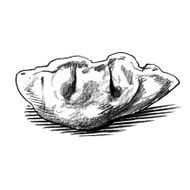
Pea Pod
In the simplest terms, it’s a half-moon with pleats.
Specimens: Basic jiaozi or guo tie, dim sum staples har gow and gow choi gau, Ukrainian varenyky, pierogi.
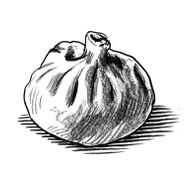
Pleated Ball
These can look like a deflating balloon or a crimped Smurf hat. Some are elongated at the pleats and terminate in a pinched topknot.
Specimens: Tibetan momo, Mongolian buuz, baozi, xiao long bao, khinkali.
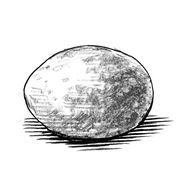
Orblike
Bouncy, egglike domes, often given structural support through the magic of starches like rice and cassava.
Specimens: Ivorian foutou, knedle ze sliwkami (Polish plum dumplings), Swedish kroppkakor, cepelinai.
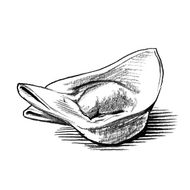
Three-cornered Hat
Or nurse’s hat, or nun’s cap, or flower bud. Tortellini are a variation of the shape.
Specimens: Cantonese wonton.
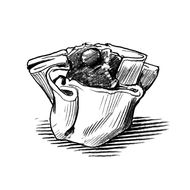
Open Pouch
Bucket-shaped, with the filling exposed on top.Specimens: Japanese shumai, Cantonese siu mai.
The Soup Dumpling Star of Instagram
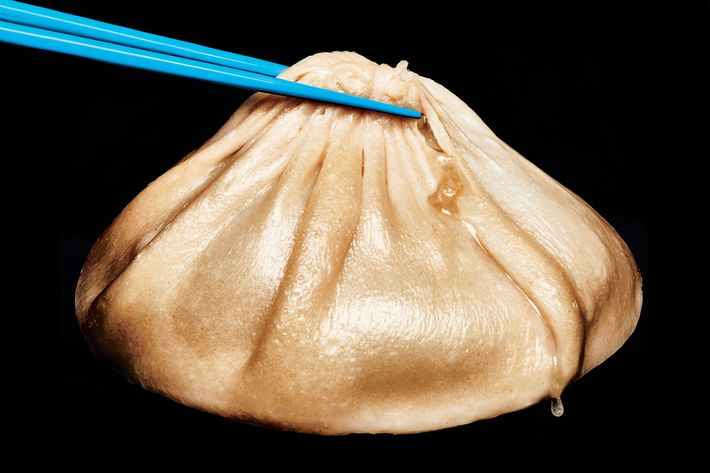
The XL XLB, which debuted at Drunken Dumpling (137 First Ave.) in September and took off on Instagram, is a riff on the guan tang bao (think supersize xiao long bao) that’s popular in Jiangsu province. While these substantial specimens are filled only with soup, Drunken’s owner Yuan Li adds a giant meatball to his version. He started off making 25 XL XLB a day; to keep up with demand, he hired additional dumpling-makers and now sells 75 (they’re generally out of dumplings by 8:30 p.m.). Here are its stats.
The broth: Made from pork, chicken, and vegetables. Amount in one dumpling: 8 oz.
The meatball: Made of crab meat, shrimp, and pork. The size of an entire regular soup dumpling, Li says.
The vitals: Width: 6 in. Height: 2.5 in. Weight: 14 oz.
Price: $11.75.
How to eat it: Each dumpling is served in a bamboo bowl with a straw. Twist the straw into the top and slurp the soup first.
Note: Do not attempt to pick it up with chopsticks (four dumplings exploded during the making of this photo).
—Robin Raisfeld and Rob Patronite
How to Eat a Regular-Size Soup Dumpling
Richard Lam — co-owner of Kung Fu Xiao Long Bao in Flushing and its East Village outpost, the Bao, where the dumplings are made to order — and Anita Lo — the chef behind Annisa, where her foie gras soup dumplings are on the menu — lay out their preferred techniques.
Richard Lam: “Make sure you pick the dumpling up from the top, where the tip is, and don’t use a chopstick to poke it underneath, because the skin is very delicate. If you try to pick it up from the bottom, most likely you’ll break it. Place the dumpling in the soup spoon, so that in case it breaks, you save the soup. Let it cool and then bite off the top and slurp all the soup inside. You can either put the dipping sauce on top of the dumpling before you bite the tip off, or bite off the tip and pour the vinegar into the dumpling. I like to do it on top. Then you can eat the rest of the dumpling in one bite or in a few pieces.”
Anita Lo: “If the dumpling is small enough, I like letting it cool down a little bit and then eating it whole. I like that bursting sensation. If the dumpling’s bigger, I’ll just bite off a little end of it — not the top, somewhere along the side — drink the soup, and then eat the rest. When you bite off the top, you risk opening the whole thing and losing the soup. I take a little piece of the ginger that you get in the dipping sauce and put that on top, just one strand on top of the dumpling. A little bit of the dipping sauce usually clings to the ginger, and the acid and the ginger cuts through all the fat.” —Hannah Goldfield
A Dumpling Through the Digestive Tract
The traditional Chinese dumpling, a boiled or steamed wheat wrapper stuffed with ground pork and cabbage, fits a lot of nutrition into a small, succulent package — hence its origin as a low-cost peasant food meant to keep bellies full for long periods of time. Here, Harvard nutrition professor and America’s Test Kitchen editor Dr. Guy Crosby describes its digestion path. By Amanda Macmillan

1. The Sauce Factor
Dumplings made with (or dipped in) soy sauce contain glutamate — an amino acid that triggers savory umami taste receptors and may help you feel full faster. Potent flavors like ginger, garlic, and vinegar can also contribute to their satiating nature.
2. The First Bite
Carbohydrates make up about 25 percent of dumplings’ weight, thanks to their doughy outer layer. And that’s where digestion starts: With your first bite, amylase enzymes in your saliva begin to break down starch from the wheat flour. That’s converted to glucose, providing a quick energy boost.
3. The Mouthfeel
The outside is soft, smooth, and slippery, with a lot of moisture and a little fat — which makes it really satisfying. Then comes the meat-and-vegetable filling, which adds contrasting texture along with sweet and savory background notes.
4. The Stomach Stretch
Protease enzymes start to break down the protein (about 7 percent of the dumpling by weight), vitamins and minerals, and essential amino acids in the filling. As the stomach stretches to accommodate the dense meat-and-dough combo, nerve receptors signal the brain to slow down and stop eating.
5. Satiety Hormones
Digestion kicks into high gear in the small intestine. Satiety hormones are released, while sugar receptors trigger the secretion of insulin — a hormone that helps the body process all that glucose.
6. Insulin Secretion
Dumplings’ protein-to-carb ratio, along with their gram or two of fiber, gives them a relatively low glycemic index — preventing the sudden, sharp blood-sugar spike, and subsequent crash, that might otherwise occur with such a starchy food. Insulin secretion peaks about two hours after your first bite and then slowly declines; a full serving (five to six small pieces) should keep hunger at bay for around four hours.
7. Emulsification
Bile acids go to work emulsifying fat molecules (about 5 percent of the dumpling by weight) so they’re more easily absorbed by the small intestine. This slows down the process slightly, adding to the dumpling’s heartiness and staying power.
8. Continuing the Journey
Over the next 24 hours, the remaining dumpling moves through the large intestine. Here, trillions of bacteria work to ferment the soluble fiber from the shredded cabbage into short-chain fatty acids, used for energy.
What to Dunk Them In

Along the Jackson Heights momo trail:
The best examples of the ground-chile condiment called sepen feature peppers — dried and/or fresh — that have been selected for their fruity, almost floral qualities. Nepalese versions tend to give equal billing to tomatoes and chiles, while momos at Indian places might get paired with tangy tomato achaar deepened in flavor with a masala made of toasted fenugreek, coriander, and cumin.
In Flushing and Chinatown:
It’s not unusual to see the food courts thronged with dumpling eaters who reach only for the tabletop squeeze bottles of black vinegar, but DIY concoctions of soy sauce, vinegar, and off-brand Sriracha are ever-popular. The four-ingredient, all-purpose sauce at Dumpling Galaxy in Flushing is about as complex as any purist might want out of a dipping sauce, but banquet chefs have been known to mellow dipping sauces with caramelized dark soy and aromatic chicken stock, along with ginger and sesame oil, to pair with more nuanced (and delicately flavored) har gow. (Also seen there: fresh minced-garlic-and-lemon sauce; crocks of the rustic chile paste known as sambal.)
At the manti mainstays of southern Brooklyn:
Lamb manti from Uzbekistan are served with a bowl of sikhdorov madzoon, or yogurt mixed with crushed garlic and plenty of mint.
With Greenpoint pierogi:
Raw chives, fried bacon, browned onion, chopped parsley, and even crisp mushroom slices might make their way onto a plate of the savory, crescent-moon-shaped dumplings, but there’s almost always a healthy dollop of sour cream on hand.
—Hugh Merwin
Building a Better Dumpling
Could the blueprint of the soup dumpling be improved upon? Nora Yoo and Drew Powers, two dumpling-obsessed architects at the downtown firm Architecture Research Office, would draw the line at a complete overhaul—“Soup dumplings are such a traditional dish, in a culture that isn’t mine,” says Powers, “so speculating on how to improve it is, like, ehh …” — but they do have a few innovative yet respectful ideas, plus some thoughts on the architectural brilliance of the traditional design.
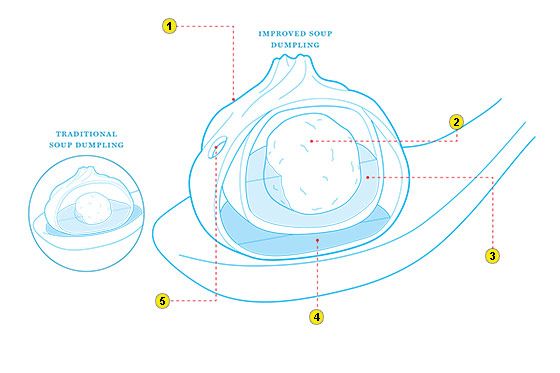
1. Keep the shape as is.
“The sphere is kind of the most perfect shape,” says Powers. “The more spherical it is, the less area you’re exposing and the less cold air will touch it — so maybe it could be even more spherical.”
2. Add more filling.
For perfect proportion: “If you double the dumpling skin, you may have to up the filling a little to keep the ratio pleasing. The double skin gives you a little more carrying capacity.”
3. Keep the broth as is.
The crux of the traditional design’s genius: “It takes into account time, heat, and temperature differences so that there’s a sequencing that happens, and you could argue that architecture is all about sequencing,” says Yoo. “You can’t install a finished tile floor before you install all the walls. It’s the same with soup dumplings: the brilliant notion that you make the broth and chill it, then once it’s chilled you can get it into the dough and then you reheat everything.”
4. Add an inner wrapper.
For longer heat retention: “A window that has two panes of glass with some airspace in between is much better than a single pane, because of the insulation factor,” says Yoo. “Same with a double-walled water bottle. A lot of buildings are now moving toward energy efficiency, and well-insulated walls are so key to that. Sustainable dumplings!”
5. Add an outer wrapper.
For optimal sauce application: “The dumpling is its own capsule, and yet you often use the spoon to start to let the liquid out and add the sauce,” says Yoo. “If you can bite the outer layer to release some of the steam and expose that there’s a dumpling inside the dumpling, then the outer layer kind of serves as a spoon, and you can pour the dipping sauce inside it.”
—H.G.
Xiao Long Bao Calculus
In 2013 and 2014, Christopher St. Cavish, a chef turned xiao long bao statistician, brought calipers and a digital scale to dumpling shops around Shanghai in hopes of finding the ideal ratio of filling to skin. The project was a supreme feat of food geekery from the start — St. Cavish deems the experience “pointless” — yet it resulted in the first-ever Shanghai Soup Dumpling Index ($15 at Kitchen Arts & Letters, 1435 Lexington Ave., nr. 93rd St.), a slick piece of design that scores the engineering of xiao long bao based on an equation: (filling + soup / thickness of skin) x 100. “The idea for the ratio was the premise that the best soup dumplings are pushing the limits of how much hot liquid you can hold in a very thin wrapper,” he says. The quest hints at a golden truth: Even mediocre soup dumplings served piping hot can trump those made with better ingredients that are served past their prime. Next up, St. Cavish has turned his sights to sheng jian bao. “It will be equally excessive,” he says. —H.M.
Twenty Mandu in Five Minutes
How the cooks in the window at Mandoo Bar (a Korean dumpling spot at 2 West 32nd Street) do it.
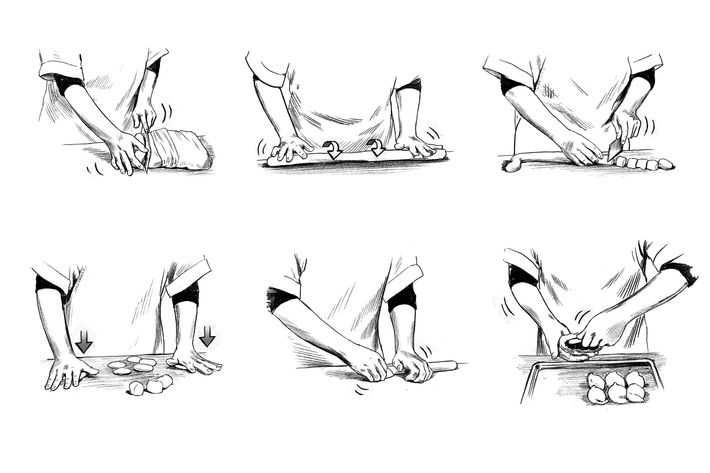
0:00 to 0:10 | The plastic bag encasing a big slab of premade dough is peeled back so that a log can be carefully sliced from its end with a cleaver.
0:10 to 0:20 | The dumpling-maker rolls the log out vigorously with her hands on a floured surface until it’s longer, thinner, and ropier.
0:20 to 0:35 | Using the cleaver, she slices half of it into ten equal segments, rolls them to the side with a quick flick of her hand, then slices up the other half.
0:35 to 1:32 | She sprinkles the pile of segments with flour, then flattens each firmly into a disk with the heels of her hand — two at a time, one under each hand — dusting or tossing with additional flour.
1:32 to 3:12 | Working again with two at a time, she flattens each disk a bit further with the heels of her hand, then stacks them together and begins to roll out the pair with a small wooden rolling pin, holding the pin steady against the table with one hand as she rocks it back and forth, and rotating the two disks quickly beneath it with her other hand, tossing each pair into a pile as it’s finished.
3:12 to 5:12 | She dusts a wooden tray with flour, then picks up one flattened disk at a time, stretching it out a bit further with her fingers before cupping it in the crook of one hand. With her other hand, she uses a small wooden paddle to scoop up bits of minced-pork filling and scrape them into the dough, pressing down after each application to pack it in tightly. Once the wrapper is filled, she folds it in half to seal it shut, then crimps the edge and gently squeezes the dumpling into a slightly rounder shape, before lining it up in the wooden tray, to be boiled or fried to order.
—H.G.
The History of the Dumpling
From healing remedies to supermarket parking lots. By Hugh Merwin
200s AD: A Chinese folktale has it that a medicine man served the first dumpling, filled with boiled meat and herbs, to villagers as a remedy for illness.
420–589: People eat dumplings in the area now known as Xinjiang, which supported heavy Silk Road traffic — wontons with wheat and millet skins are later found intact during an archaeological excavation of the Turpan Basin.
1300: Gnocchi made from bread crumbs or flour start circulating as written recipes in Italy.
1600: The word dumpling starts appearing in the English language, with the Oxford dictionary later ascribing the “more or less globular” dough’s etymology to Low German.
1839: Lettice Bryan’s cookbook The Kentucky Housewife includes a number of sweet, savory, and suet-heavy dumpling recipes of possible Indo-European influence, including one for stewed squirrel with dumplings.
1875: The soup dumpling takes Nanxiang by storm.
1911: Apple dumplings are banned from the Mount Holyoke campus after professors claim they “cause the students to come to afternoon classes in a languid condition.”
1958: Chinese restaurants have existed in America by now for 110 years, but immigrants are reluctant to cook authentic food, so when Joyce Chen, a northern-style Chinese chef, opens shop in Boston, she dubs her pot stickers “Peking ravioli.”
1996: Da Niang Dumplings is founded in Jiangsu in response to chains like McDonald’s. It grows to nearly 500 locations.
2009: Tim Ho Wan in Hong Kong, which slings dim sum for $5 per plate, gets a Michelin star and lands the “world’s cheapest” moniker.
2016: WeChat creates a market for clandestine dumplings in cities like L.A., where pickups of regional flavors like pork-and-cucumber take place in supermarket parking lots.
*This article appears in the December 12, 2016, issue of New York Magazine.


